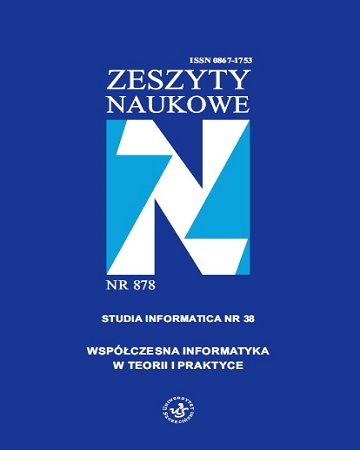
ISSN: 0867-1753
eISSN: 2300-410X
OAI
DOI: 10.18276/si.2015.38-07


Issue archive /
ZN 878 SI nr 38
Zastosowanie metody mini-modeli opartej na hipersześcianie w procesie modelowania danych wielowymiarowych
(Application of mini-models method based on hypercube in the modeling process of multidimensional data)
| Authors: |
Marcin
Pietrzykowski
Zachodniopomorski Uniwersytet Technologiczny w Szczecinie, Wydział Informatyki |
| Keywords: | mini-model local regression k-nearest neighbor mathematical modeling instance based learning |
| Data publikacji całości: | 2015 |
| Page range: | 13 (91-103) |
Abstract
The article presents self-learning method of mini-models (MM-method) based on polytopes in multidimensional space. The method is new and is an object of intensive research. MM method is the instance based learning method and uses data samples only from the local neighborhood of the query point. Group of points which are used in the model-learning process is constrained by a polytope area. The MM-method can on a defined local area use any approximation algorithm to compute mini-model answer for the query point. The article describes a learning technique based on hyper-spherical coordinate system. The method was used in the modeling task with multidimensional datasets. The results of numerical experiments were compared with other instance based methods.
Download file
Article file
Bibliography
| 1. | Bottou L., Vapnik V. (1992), Local Learning Algorithms, „Neural Computation”, vol. 4, iss. 6, s. 888–900. |
| 2. | Bronshtein I., Semendyayev K., Musiol G., Muhlig H. (2007), Handbook of Mathematics, Springer. |
| 3. | Celikoglu H.B. (2006), Application of radial basis function and generalized regression neural networks in non-linear utility function specication for travel mode choice modelling, „Mathematical and Computer Modelling”, vol. 44, iss. 7–8, s. 640–658. |
| 4. | Fan J.Q. (1992), Design-adaptive nonparametric regression, „Journal of the American Statistical Association”, vol. 87, iss. 420, s. 998–1004. |
| 5. | Fix E., Hodges J.L. (1951), Discriminatory analysis, nonparametric discrimination: Consistency properties, Randolph Field, s. 1–21. |
| 6. | Hollash S.R. (1991), Four Space Visualization of 4D Objects, Arizona State University. |
| 7. | Fukunaga K., Narendra P.M. (1975), Branch and bound algorithm for computing k-nearest neighbors, „IEEE Transactions on Computers”, vol. C24, iss. 7, s. 750–753. |
| 8. | Moon P., Spencer D. (1988), Field theory handbook: including coordinate systems, differential equations, and their solutions, Springer. |
| 9. | Park J., Wasenberg J. (1991), Universal approximation using radial basis functions network, „Neural Computation”, vol. 3, s. 246–257. |
| 10. | Piegat A., Wąsikowska B., Korzeń M. (2010), Zastosowanie samouczącego się trzypunktowego minimodelu do modelowania stopy bezrobocia w Polsce, „Studia Informatica”, nr 27, s. 59–69. |
| 11. | Piegat A., Wąsikowska B., Korzeń M. (2011), Differences between the method of mini-models and the k-nearest neighbors an example of modeling unemployment rate in Poland, Information Systems in Management IX-Business Intelligence and Knowledge Management, |
| 12. | Pietrzykowski M. (2011a), Comparison of effectiveness of linear mini-models with some methods of modelling, Młodzi Naukowcy dla Polskiej Nauki. CRE ATI VETI ME, Kraków, s. 113–123. |
| 13. | Pietrzykowski M. (2011b), The use of linear and nonlinear mini-models in process of data modeling in a 2D-space, Nowe trendy w Naukach Inżynieryjnych. CRE ATI VETI ME, Kraków, s. 100–108. |
| 14. | Pietrzykowski M. (2012), Effectiveness of mini-models method when data modelling within a 2D-space in an information deficiency situation, „Journal of Theoretical and Applied Computer Science”, vol. 6, no. 3, s. 21–27. |
| 15. | Pietrzykowski M. (2013), Mini-models working in 3D space based on polar coordinate system, Nowe trendy w Naukach Inżynieryjnych 4. Tom II , CRE ATI VETI ME, Kraków, s. 117–125. |
| 16. | Pietrzykowski M. (2014), Comparison between mini-models based on multidimensional polytopes and k-nearest neighbor method: case study of 4D and 5D problems, „Advances in Intelligent Systems and Computing”, vol. 342, s. 107–118. |
| 17. | Pluciński M. (2012a), Mini-models – Local Regression Models for the Function Approximation Learning, w: Proceedings of IC AISC 2012, Part II , LNCS 7268, red. L. Rutkowski, Springer-Verlag, Berlin–Heidelberg, s. 160–167. |
| 18. | Pluciński M. (2012b), Nonlinear ellipsoidal mini-models – application for the function approximation task, „Przegląd Elektrotechniczny”, r. 88, nr 10b, s. 247–251. |
| 19. | Pluciński M. (2014), Application of Mini-Models to the Interval Information Granules Processing, „Advances in Intelligent Systems and Computing”, vol. 342, s. 37–48. |
| 20. | Poggio T., Girosi F. (1990), Network for approximation and learning, „Proceedings of the IEEE ”, vol. 78, no. 9, s. 1481–1497. |
| 21. | Polyanin A., Manzhirov A. (2010), Handbook of Mathematics for Engineers and Scientists, Taylor & Francis. |
| 22. | Ruppert D., Wand M.P. (1994), Multivariate locally weighted least-squares regression, „Annals of Statistics”, vol. 22, iss. 3, s. 1346–1370. |
| 23. | Specht D.F. (1991), A General Regression Neural Network, „IEEE Transactions on Neural Networks”, vol. 2, no. 6, s. 568–576. |
| 24. | Uci machine learning repository, http://archive.ics.uci.edu/ml (25.04.2015). |